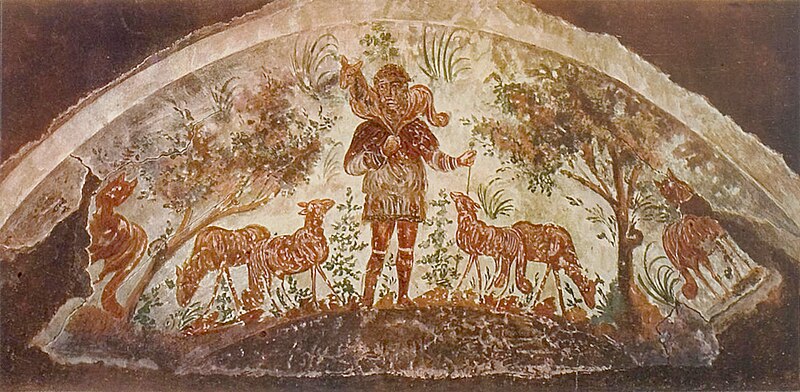
About the text: As is the case in any pilgrimage, prayer and penance mark the life of a Christian. Just as it was not enough for the Israelites to pass through the Red Sea, but they needed a time of purification and penance in the desert, so do we need to do penance in addition to our baptism as we make our way through the desert of life to the place prepared for us by Christ.
—
The many forms of penance in Christian life
1434. The interior penance of the Christian can be expressed in many and various ways. Scripture and the Fathers insist above all on three forms, fasting, prayer, and almsgiving (cf. Tob 12:8; Mt 6:1–18), which express conversion in relation to oneself, to God, and to others. Alongside the radical purification brought about by Baptism or martyrdom they cite as means of obtaining forgiveness of sins: efforts at reconciliation with one’s neighbor, tears of repentance, concern for the salvation of one’s neighbor, the intercession of the saints, and the practice of charity “which covers a multitude of sins” (1 Pt 4:8; cf. Jam 5:20).
1435. Conversion is accomplished in daily life by gestures of reconciliation, concern for the poor, the exercise and defense of justice and right (cf, Am 5:24; Is 1:17), by the admission of faults to one’s brethren, fraternal correction, revision of life, examination of conscience, spiritual direction, acceptance of suffering, endurance of persecution for the sake of righteousness. Taking up one’s cross each day and following Jesus is the surest way of penance (cf. Lk 9:23).
1436. Eucharist and Penance. Daily conversion and penance find their source and nourishment in the Eucharist, for in it is made present the sacrifice of Christ which has reconciled us with God. Through the Eucharist those who live from the life of Christ are fed and strengthened. “It is a remedy to free us from our daily faults and to preserve us from mortal sins” (Council of Trent: DS 1638).
1437. Reading Sacred Scripture, praying the Liturgy of the Hours and the Our Father—every sincere act of worship or devotion revives the spirit of conversion and repentance within us and contributes to the forgiveness of our sins.
1438. The seasons and days of penance in the course of the liturgical year (Lent, and each Friday in memory of the death of the Lord) are intense moments of the Church’s penitential practice (cf. Sacrosanctum Concilium 109–10). These times are particularly appropriate for spiritual exercises, penitential liturgies, pilgrimages as signs of penance, voluntary self-denial such as fasting and almsgiving, and fraternal sharing (charitable and missionary works).
1439. The process of conversion and repentance was described by Jesus in the parable of the prodigal son, the center of which is the merciful father (cf. Lk 15:11–24): the fascination of illusory freedom, the abandonment of the father’s house; the extreme misery in which the son finds himself after squandering his fortune; his deep humiliation at finding himself obliged to feed swine, and still worse, at wanting to feed on the husks the pigs ate; his reflection on all he has lost; his repentance and decision to declare himself guilty before his father; the journey back; the father’s generous welcome; the father’s joy—all these are characteristic of the process of conversion. The beautiful robe, the ring, and the festive banquet are symbols of that new life—pure, worthy, and joyful—of anyone who returns to God and to the bosom of his family, which is the Church. Only the heart of Christ who knows the depths of his Father’s love could reveal to us the abyss of his mercy in so simple and beautiful a way.
The end of our earthly pilgrimage
1013. Death is the end of man’s earthly pilgrimage, of the time of grace and mercy which God offers him so as to work out his earthly life in keeping with the divine plan, and to decide his ultimate destiny. When “the single course of our earthly life” is completed (Lumen Gentium 48§3), we shall not return to other earthly lives: “It is appointed for men to die once” (Heb 9:27). There is no “reincarnation” after death.
—
Excerpts from the Catechism of the Catholic Church © Amministrazione del Patrimonio della Santa Apostolica and © Libreria Editrice Vaticana – 00120 Città del Vaticano. All rights reserved. International copyright handled by Libreria Editrice Vaticana; © Concacan Inc., 1994, 1997, 2016 for the English translation in Canada. All rights reserved. Reproduced with permission of the Canadian Conference of Catholic Bishops. Visit cccbpublications.ca.

Leave a Reply